Pilgrimage to
Amarnath Cave
One
of the holy trinity, Shiva is a living god.
The most sacred and most ancient book of India,
the Rig Veda evokes his presence in its hymns.
Vedic myths, ritual and even astronomy testify to
his existence from the dawn of time. But Shiva,
the destroyer, the mendicant, is indefinable: he
is the great yogi, the guardian of the absolute.
His actions are the themes of the myths in which
his nature unfolds.
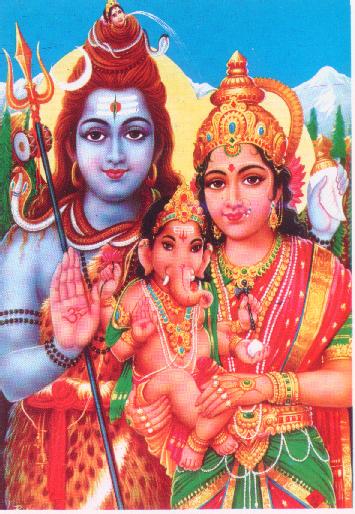
Shiva and Parvati with Ganesh
Shiva, he of the
opposites and the absolute, is known to have made
his home in the Himalayas. He built no house nor
shelter, not for himself nor for his bride. He was
an ascetic, and yet married; he could be both for
"he was the wild god sporting in the forest
or taking his ease on a cloud."
Legend has it that Shiva
recounted to Parvati the secret of creation
in a cave in Amarnath. Unknown to them, a pair of
mating doves eavesdropped on this conversation and
having learned the secret, are reborn again and
again, and have made the cave their eternal abode.
Many pilgrims report seeing the doves-pair when
they trek the arduous route to pay obeisance
before the ice-lingam (the phallic symbol of
Shiva).
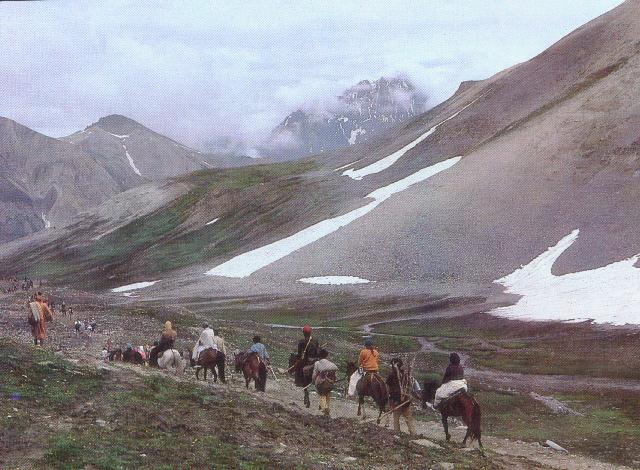
Making their way across Mahagunas pass.
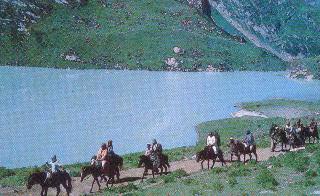
Along the spectacular Sheshnag Lake.
The trek to Amarnath, in the month of
Shravan (July-August) has the devout flock to this
incredible shrine, where the image of Shiva, in
the form of a lingam, is formed naturally
of an ice-stalagmite, and which waxes and wanes
with the moon. By its side are, fascinatingly, two
more ice-lingams, that of Parvati, and of their
son, Ganesha.
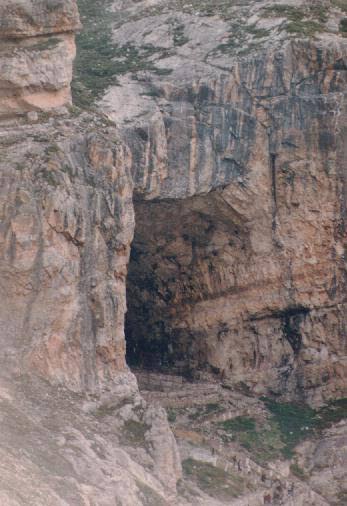
Entrance to the Amarnath Cave.
A legend has it that when Kashyap
Reshi drained the Kashmir valley of water (it
was believed to have been a vast lake), the cave
and the lingam were discovered by Bregish Reshi
who was travelling the Himalayas. When people
heard of the lingam, Amarnath for them became
Shiva's abode and a center of pilgrimage.
Whatever the
legends and the history of Amarnath's discovery,
it is today an extremely crucial centre of
pilgrimage, and though the route is as difficult
to trespass as it is exciting, every annum,
millions of devotees from the subcontinent come to
pay homage before Shiva in one of his Himalayan
abodes.
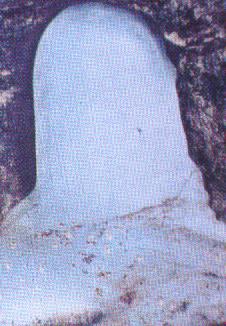
The Shivalinga.
Situated in
a narrow gorge at the farther end of Lidder
valley, Amarnath stands at 3,888 m and is 44.8 km
from Pahalgam and 141 km from Srinagar.
Though the original pilgrimage subscribes that the
yatra be undertaken from Srinagar, the more common
practise is to begin journey at Pahalgam, and
cover the distance to Amarnath and back in five
days. Pahalgam is 96 km from Srinagar.
The trek
from Pahalgam to Amarnath cave is on an ancient
peregrine route. The 45-km distance is covered in
four days, with night halts at Chandanwari,
Sheshnag (Wawjan) and Panchtarni.
The distance from Pahalgam to Chandanwari (12.8
km) is covered in about five to six hours, and the
trail runs alung the Lidder river. Pilgrims camp
here on the first night out. A major attraction
here is a bridge covered, year round, with ice
even though the surroundings are free from it.
The next
day's trek, of 13 km, is through spectacular,
primeval countryside, and the main centre of
attraction is Sheshnag, a mountain which derives
its name from its seven peaks, resembling the
heads of a mythical snake. The journey to Sheshnag
follows steep inclines up the right bank of a
cascading stream and wild scenery untouched by
civilization. The second night's camp at Wawjan
overlooks the deep blue waters of Sheshnag lake,
and glaciers beyond it.
There are
legends of love and revenge too associated with
Sheshnag, and at the camp these are recounted by
campfires, to the stillness of a pine-scented,
Himalayan night.
The third
day's 13 km trek steadily gains height, winding up
across Mahagunas Pass at 4,600 m and then
descending to the meadow-lands of Panchtarni, the
last camp enroute to the holy cave.
From
Panchtarni to Amarnath is only 6 km, but an early
morning's start is recommended for there is a long
queue awaiting entrance to the cave. The same day,
following darshan, devotees can return to
Panchtarni in time for lunch, and continue to
Wawjan to spend the fourth night out; or continue
further to Zojibal, returning to Pahalgam on the
fifth day.
Entrance to
the cave is regulated, and darshan a hasty affair
for there are many others waiting outside to pay
homage before the awesome Shivalinga. The devotees
sing bhajans, chant incantations, and priests
petform aarti and puja, invoking the blessings of
Shiva, the divine, the pure, the absolute. For
those who journey with faith, it is a rewarding
experience, this simple visitation to a
cave-shrine, the home of the Himalayan mendicant
who is both destroyer and healer, the greatest of
the Hindu deities.
Click here for more articles on
Amarnath Pilgrimage.
| 